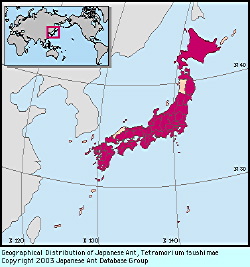
|
species
|
Tetramorium tsushimae
|
 |
Japanese Name
|
Tobiiro-shiwa-ari
|
Original Reference
|
|
Emery, C. (1925c)
|
Synonym
|
|
Tetramorium caespitum semileve var. jacoti Wheeler, 1923 [unavailable],
Tetramorium caespitum subsp. tsushimae Emery, 1925c,
Tetramorium caespitum subsp. jacoti Wheeler, 1927d,
Tetramorium caespitum subsp. jacoti var. annectens Wheeler, 1927d [unavailable],
Tetramorium annectens Pisarski, 1969a,
Tetramorium tsusimae: Bolton, 1995,
|
Description
|
|
Total length of workers around 2.5 mm. Body color brown to dark brown. Antennae 12-segmented. Anterior margin of clypeus slightly convex, without median notch. Frontal carina short, obscure behind the level of the eyes. Propodeal spines small, dentiform. Petiolar peduncle short and broad. Dorsum of head covered with fine longitudinal rugulation. Sculpture on mesosoma more irregular, but mostly longitudinal.
|
Remarks
|
|
In Japan this species is found in open land, nesting under stones. It is one of the most common ants in southern parts of the country.
|
|

Distribution
|
|
Hokkaido, Honshu, Shikoku, Kyushu, Tsushima I.; Holarctic.
|
|
Editor
|
|
Original text by Kazuo Ogata and Keiichi Onoyama. English translation by Kazuo Ogata, edited by Robert W. Taylor.
|
|